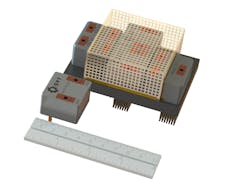This article is part of the TechXchange: Gallium Nitride (GaN).
What you’ll learn:
- The new revolution in power.
- How GaN-based motor drives can significantly reduce power consumption.
Electric motors are one of the biggest consumers of energy, both in business and consumer products. HVAC, refrigerators, conveyor belts, robots, and many other devices rely on them for operation. However, a number of issues plague high-power motors, including power consumption, thermal management, and the electromagnetic interference (EMI) that affects variable-frequency drivers and their cables.
Among the companies working to develop solutions for driving motors more efficiently is Quantum Power Transformation (QPT), a UK-based developer of compact gallium-nitride (GaN)-based modules. The company is creating technology to develop motor drivers that operate at extremely high switching speeds, taking advantage of GaN’s piezoelectric properties. It recently won the ABB Power Density Start-up Challenge in 2023 for Motor Drive Products, leveraging its qGaN technology to solve the issues of RF and overheating, saving a significant amount of power in motors and drives.
QPT recently appointed Rupert Baines as its CEO, a veteran of the semiconductor industry with C-level roles including CEO of UltraSoC (sold to Siemens) and CMO of Codasip. Electronic Design recently sat down with Baines to talk about his role and how QPT is addressing the issues involved in developing next-generation GaN-based motor drivers that substantially increase energy efficiency while reducing EMI and thermal-management issues.
Rupert, congratulations on your appointment to this new company. We've dealt with each other from your days back at Codasip and some of the other companies that you've been involved in, and it's always nice to see a friend moving up in the industry. QPT stands for Quantum Power Transformation, what does that mean to you?
Power transformation is very appropriate. We are talking about transforming power in an engineering sense. The products we make take power in one form into a different form, and we are talking about transforming the power industry with some revolutionary new products. The connection with quantum is when you talk about quantum bandgaps and quantum energy levels inside transistors.
We're using gallium-nitride transistors, wide-bandgap transistors, in some very revolutionary ways to achieve things that nobody else can manage. [We look] to really deliver on the potential of gallium-nitride transistors in a way that the industry has not seen before.
People have been watching the industry, us included, and wide-bandgap transistors are fomenting a new power revolution. A lot of people don't even recognize that there is a power revolution going on.
I completely agree. I think you know it's an intersection of several different things, and that’s one of the reasons I'm so excited to join QPT. From a macro trend in terms of sort of the biggest challenges facing the planet, we have climate change and the need for net zero.
In the move to electrification, we've got amazing innovation coming through in the wider industry. You know the efficiencies and the cost reductions in solar cells in batteries, the adoption of heat pumps, and the adoption of electric vehicles. We're getting wholly new classes of transistors.
We've had silicon IGBTs and power MOSFETs for about 40 years, and now all of a sudden, we've got silicon carbide and we've got GaN, which I believe actually has the opportunity to leapfrog silicon carbide as well as obsolete silicon MOSFETs for power in a remarkably fast time scale to deliver amazing results.
Well, one of the aspects of GaN, one of the reasons it has such promise, is that it is a piezoelectric semiconductor. The switching speeds are its primary asset after the wide bandgap, obviously. We assume that your company's breakthroughs are focused on the circuit topologies that are enabled by these advanced switching capabilities.
Absolutely right. It's got the wide-bandgap characteristics; it's got amazing conduction performance; amazing electrical performance just in standalone, and a lot of people are using that today. This is why you know all the laptop and mobile phone chargers are getting so much smaller. But the interesting thing is they're not pushing the envelope yet at all, and they're barely scratching the surface of the speed achievable. What we're doing is creating a device with a resonant circuit.
A product using soft switching makes things much easier, but it's still running at maybe only 100 kHz. Whereas what QPT is talking about doing is hard switching for motors, which is a much more difficult situation, but it is much more commercially important. We're already at 6 kW and we've got a road map up to tens of kilowatts.
The interesting thing is that wide-bandgap transistors are pushing the development of advanced circuits, which are then pushing the performance of the magnetics and passives and other components with these new topologies.
Yes, this is where it gets intriguing, since GaN lets you switch very, very fast.
Some motor drivers today, many of them are something like 4 kHz, and a charger like the ones we’re now seeing is doing soft switching that's at around 100 kHz. We're talking about switching 1 MHz, so massively faster, and we talked about hard switching, which is so much more difficult. It’s a challenging application, hard switching, working with many tens of amps, which at 1 MHz is really, really difficult.
In order to do that, you need a weird collision of power technology and RF technology. There are plenty of engineers in the world who work with tens or hundreds of amps. There are also engineers in the world who work at gigahertz speeds, but they tend to be talking about milliwatts. They talk about things like dBMS and strange measures like that because they are RF people and it's black magic. So, you're talking about 20 dBM, 40 dBM at gigahertz frequencies with tens or hundreds of amps, and that is an incredibly complicated thing to do.
It needs really, really smart engineers. But at QPT we've got some really, really smart engineers and it means you need to redesign just about everything in your circuits.
So, what about the passives and the magnetics?
You know, you've got to approach them differently. Some of them are unique components that we've designed, so there are filters. The inductors are truly unique because QPT has designed them to handle these high currents at high frequencies, and you can't just phone up your local distributor. There's some wonderful distributors, but they don't sell this kind of gear, cause nobody does, because nobody's ever needed it before.
So, we've invented it and that goes all the way through to the approach, to how you do the transistors differently. The processors, the inductors, the filters, the rectifiers, everything has to be rethought.
Are you going to be supplying final drives and some finished products, or are you going to be supplying core technology? How are you going to manifest the company's solutions?
We're going to be supplying modules and drives. At gigahertz frequencies, things like the circuit-board design and signal integrity are really tricky. It's not something that you can just do as a reference design; it's got to be a completely integrated module. We've got prototypes now, and we're moving into customer evaluations and trials.
As you know, there was a recent announcement from ABB that we won their Power Density Start-up Challenge, and that they're working with us for some of their motors. They've got some fantastic new next-generation motors, so we're delighted to be working with them. And we've got a couple of other equally significant major customers who we're doing evals and testing with now.
Is there anything else that you wanted to talk about the company, the future, or anything that we didn't touch on?
We're recruiting, so if there are any engineers out there who are interested, we would love to talk to you.
Read more articles in the TechXchange: Gallium Nitride (GaN).



